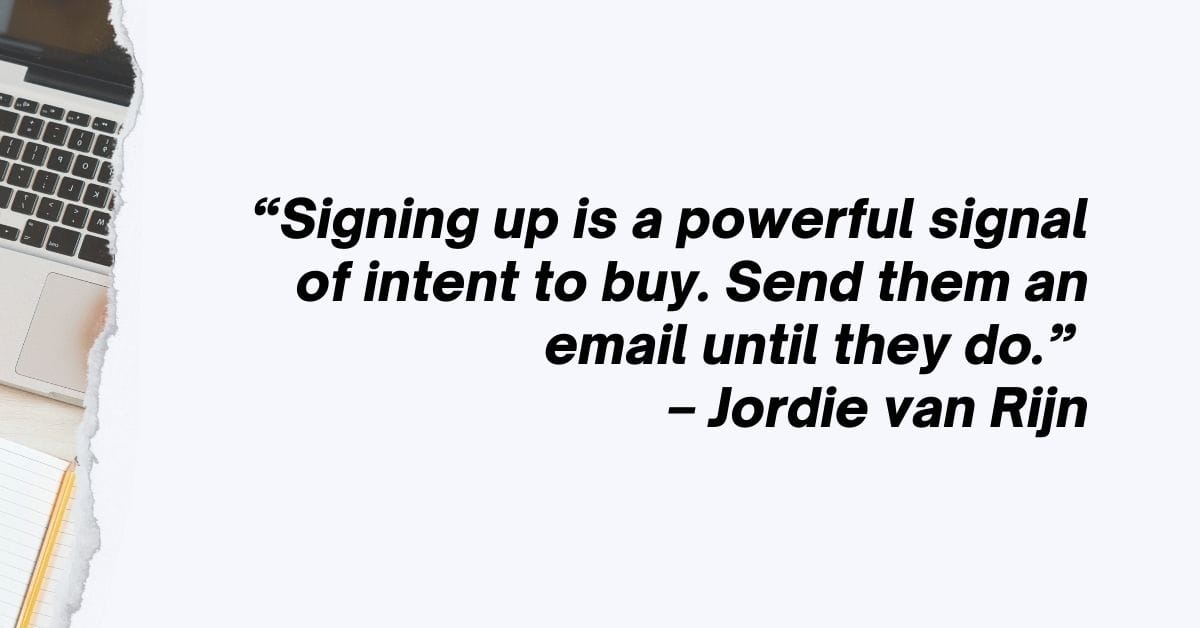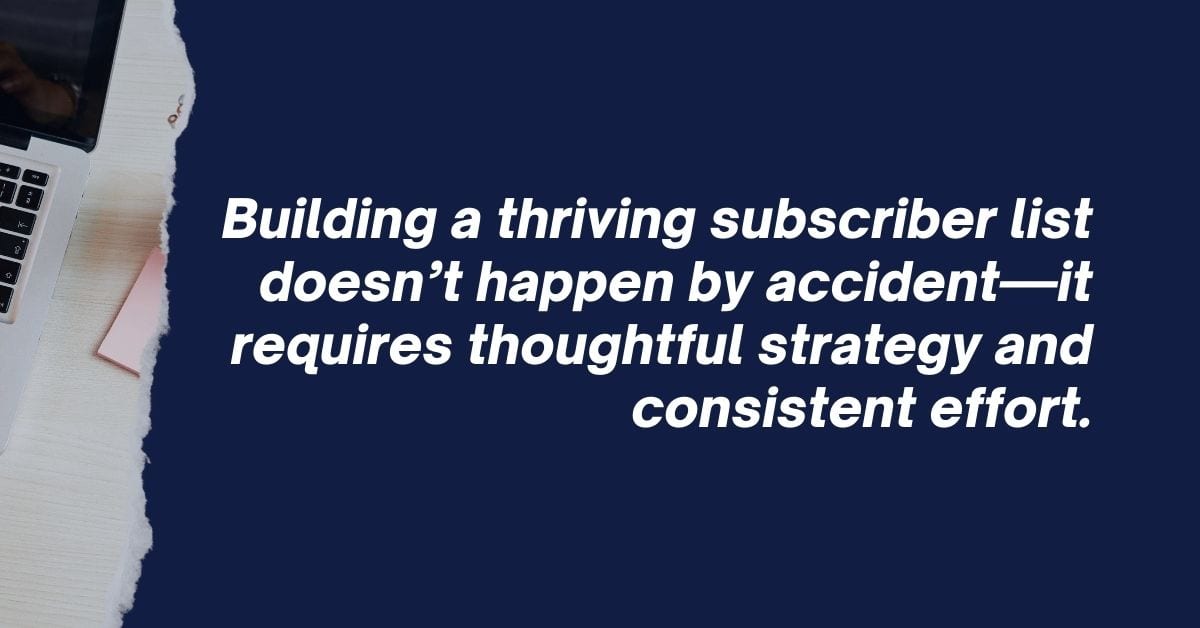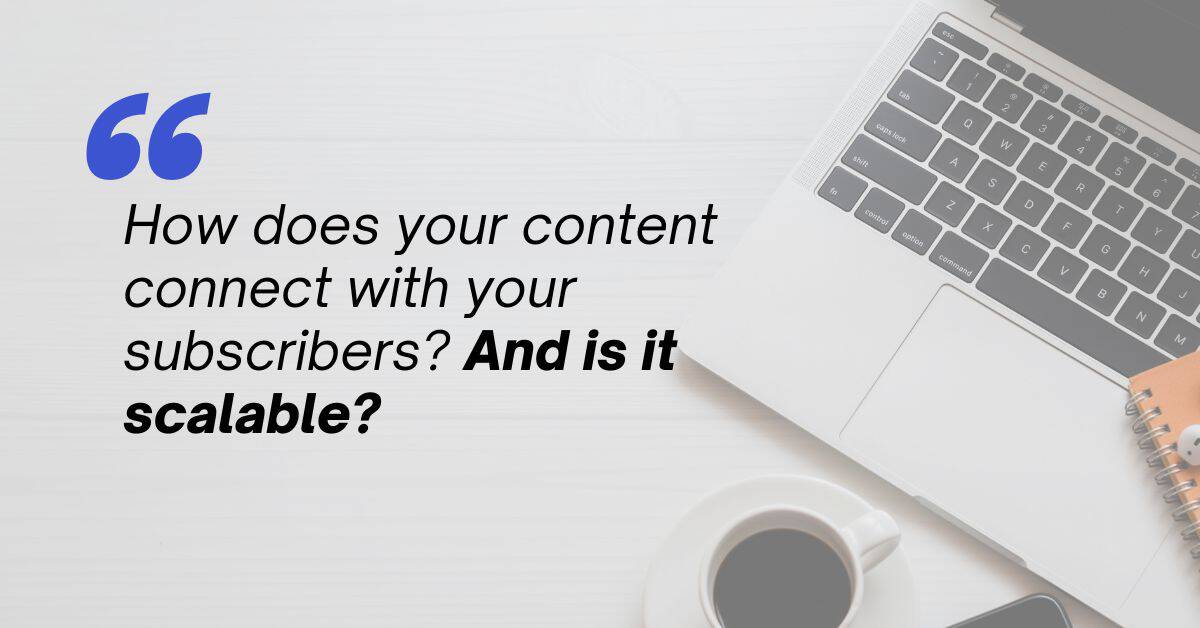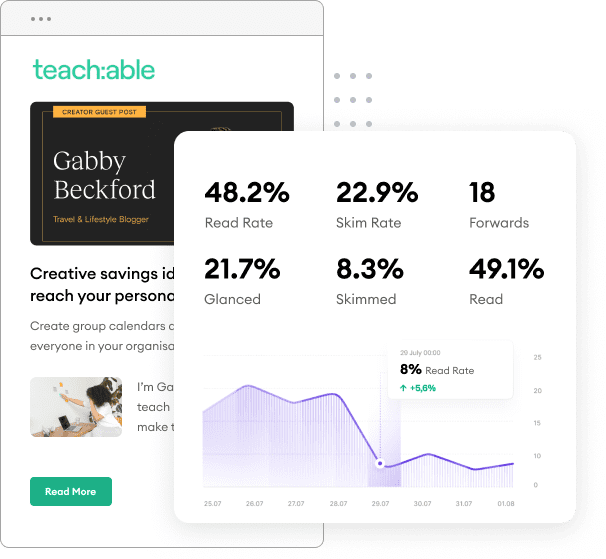A blog newsletter is a powerful way to convert website visitors who land on your blog—and build strong connections that lead to higher content ROI and business growth.
When paired with a solid content strategy, your blog email subscription allows you to directly deliver updates, insights, and personalized content to your audience, keeping your users engaged beyond their first visit.
With automation, this process becomes seamless and scalable, letting you focus on crafting great content while your email system works in the background.
Today and over the next few articles, we’re going to look at some of the strategies behind crafting a successful automated email subscription for your blog, how to set it up with some of the top ESPs, and how to find smart ways to scale your work so that you can continue to publish incredible content, without the burnout.
Blog newsletter subscriptions are a fairly standard practice for modern digital marketers.
The tactical approach is straightforward:

There are two key advantages to this approach to lead gen and nurturing: personalization and automation.
Although every new subscriber goes through the same general flow (sign up, then receive email), you have the ability to fully personalize this experience to align with your top user personas and customer pain points/goals.
We’ll talk more about lead magnet strategy in a bit, but the top level takeaway is that your website visitors can immediately connect with the resources that you’re offering on your website as an incentive to sign up for your email subscription.
You can continue to personalize your messaging and pitches based on known actions such as:
Depending on what CRM or ESP you’re using, you can auto-segment all incoming leads with tags or custom fields to ensure they’re associated with whichever lead magnet(s) they requested.
With the right setup, your team will be able to ensure that every new subscriber receives the same attention and value, whether it’s through an engaging welcome message or timely updates.
Leveraging your CRM/ESP’s automation capabilities allows you to automate your personalized messages or actions, which makes each point of interaction feel timely and relevant to your subscribers.
The more data you’re able to collect from your subscribers, the more relevant your messaging will be…and it will open the door to additional workflows like:

Let’s take a moment to talk about opt-in incentives.
One of the most effective ways to encourage blog visitors to subscribe to your email list is by offering an opt-in incentive, also known as a lead magnet. This is a valuable resource or benefit you provide in exchange for a visitor’s email address.
At this point in time, we all know what happens when you share your email address online.
For many companies working with cold or lukewarm audiences, a simple promise of “updates” or “newsletters” often isn’t enticing enough to motivate them to subscribe. (Unless you regularly publish kick-ass content, in which case…that might actually work).
In general, however, your goal is to discover what your clientele want…and offer it to them for free, in exchange for an email address. Typically referred to as an opt-in incentive, this piece of gated content is the linch pin for your lead gen strategy.
The best opt-in incentives align with your blog’s niche and audience interests. They also solve a problem, fulfill a need, or provide exclusive insights.
Depending on what your blog content strategy looks like, you might gravitate towards one of these formats:
The process of delivering your incentive should be seamless and automated. After a visitor fills out your sign-up form, the incentive can be emailed to them as part of an automated welcome message.
Most email marketing platforms, such as MailChimp and HubSpot, allow you to create workflows that automatically send the resource after the subscription is confirmed.
If you’re offering downloadable content, ensure that the file is easy to access. For example, hosting the file on a cloud platform like Amazon AWS, Google Drive, Dropbox, or embedding it directly in your email can prevent delivery issues.
Building a thriving subscriber list doesn’t happen by accident—it requires thoughtful strategy and consistent effort.
Fortunately, the tactic has been around long enough that there are a lot of proven techniques for encouraging sign-ups, crafting compelling calls-to-action, maintaining compliance, and optimizing your blog’s content strategy to grow your list.

Here are a few tips to maximize the effectiveness of your opt-in incentive & overall blog newsletter strategy:
Incentives can supercharge your CTA. Readers are more likely to subscribe to your blog newsletter when offered something tangible in return, such as a free eBook, a downloadable guide, or access to exclusive blog content. Make sure the incentive is valuable and aligns with your audience’s interests or pain points.
“We need to stop interrupting what people are interested in and be what people are interested in.”– Craig Davis
Depending on your industry and vertical, this might look significantly different than some of the other examples you find online. For instance, a travel blog might offer a downloadable packing checklist, while a tech blog might share a PDF with productivity tips.
Other examples include:
Tip: The more targeted and personalized the incentive, the better your chances of increasing opt-in rates.
It’s difficult to stand out online. But don’t fall into the temptation of sacrificing clear copy for clever copy. Researchers like the Nielsen Norman Group often estimate that you have 10 seconds or less to capture the attention of your website visitor…but that’s when you’re talking an entire website.
Headlines and CTAs have a split second to make an impression and capture the attention of your viewer, which is why it’s so important to get to the point quickly. In this case, the “point” is your value statement and pitch.
In this pitch, you’ll want to clearly state what users will get and why it benefits them. Try to avoid industry jargon while incorporating a sense of urgency and power words to generate a feeling of excitement (e.g., “Limited-time bonus,” “Instant access,” “Exclusive offer”).
Example:
“Join now and get your FREE 10-step productivity guide to transform your workday in minutes!”
I just mentioned it, but it’s worth emphasizing on its own: if you can create a sense of urgency and scarcity around your offer, it’s more likely to encourage immediate action.
Common approaches often include using text like “Only available for the next 24 hours” or “First 100 subscribers get a bonus resource,” although you can also use countdown timers and other visuals to get the point across.
Marketing and messaging is an ever-changing game. Take time to test and assess what’s working with your opt in incentives and continually tweak to improve your conversion rates.
To get you started, a few sample variables you could test include:
Just like copy, try to keep a clean, visually appealing form design with a strong Call-to-Action (CTA) button. The form should be located in a prominent location on your website so it can easily catch the eye of your website visitors.
There are a lot of great resources out there for form design (like this piece by Mike Hakob or this piece from Jotform) to help you design forms that will easily convert your ideal audience.
Tip: Test CTA button text. For example, “Download Now” often outperforms generic options like “Submit.”
Is the form visible on the page? Does it stand out in a way that captivates interest and amplifies the user experience? Where you place your email sign-up forms on your blog can have a significant impact on your subscription rates.
Visitors are more likely to subscribe if:
Inline forms, embedded within blog posts, can be effective since they present readers with an opportunity to subscribe while they’re already engaged with your content.
In addition to inline forms, you’ll also come across more dynamic forms that use motion design to gain a user’s attention and incentivize them to sign up.
Dynamic forms include:
For all of these, timing is crucial to conversion success. Forms triggered after a certain amount of scrolling or time spent on the page are less intrusive than immediate pop-ups and tend to convert better.
For larger campaigns, creating dedicated landing pages for email sign-ups can drive targeted traffic and higher conversion rates, especially when paired with social media or ad campaigns.
Growing your list ethically is as important as growing it quickly. Compliance with regulations like GDPR and CAN-SPAM builds trust with your audience and protects your reputation.
To ensure compliance, make it clear what readers are signing up for and how their data will be used. Transparency fosters trust, and subscribers are more likely to engage with your emails when they know what to expect.
A few of the common compliance requirements include:
The Double Opt-In
Double opt-ins require users to confirm their blog newsletter subscription via email. They also add another layer of consent to protect your list from fake or invalid sign-ups.
Unsubscribe Links
Legally, every email has to have an “unsubscribe” link that’s easy to find. Ironically, making it easy for people to unsubscribe also enhances your credibility by giving subscribers control over their preferences. The more credibility you have, the more likely
Blog newsletter subscriptions can be integrated seamlessly into your broader content strategy.
For example, you can use content upgrades to encourage users to sign up. These upgrades offer bonus materials tied to specific blog posts, such as a checklist, template, or detailed guide, providing readers with immediate value for subscribing.
Regularly sending blog roundups or content digests is another way to engage your audience. These emails, which recap your most popular or recent posts, keep your subscribers connected to your blog and encourage them to return. For greater personalization, segment your audience based on their interests or behaviors, and tailor your email content to match these preferences.
Optimizing your blog for search engines can indirectly but powerfully support your email list growth. By targeting keywords that align with lead magnets or subscription offers, you can attract organic traffic from readers actively seeking resources you provide. For example, a food blog could rank for “meal planning template” and direct traffic to a sign-up form offering that template as a free download.
Internal linking also plays a key role. Linking to your sign-up forms or dedicated landing pages within blog content ensures readers can easily access subscription opportunities. Content clusters, which group related blog posts around a central topic, create a natural flow of traffic that can guide readers toward signing up.
Getting started with automated email subscriptions involves a series of straightforward steps.
First, select an email marketing platform that aligns with your needs. Popular options include MailChimp for its simplicity, Active Campaign for its advanced workflows, and HubSpot for its all-in-one marketing capabilities. After signing up, explore the platform’s features to familiarize yourself with its interface and tools.
Next, design a sign-up form to capture subscriber information. This form will typically include fields for names and email addresses, although you can customize it to collect additional data, like interests or preferences.
Create your first automated workflow. A good starting point is a welcome email sequence, triggered whenever someone subscribes. Use this email to thank readers for joining, introduce yourself or your blog, and provide links to popular or relevant posts. A clear and friendly tone in your welcome email sets the stage for a positive relationship with your subscribers.
Embed the form on your blog in high-visibility locations, such as the homepage, the sidebar, or within blog posts. Many platforms provide copy-and-paste code or plugins to make this process quick and painless.
Finally, test your system by signing up yourself. This step ensures that everything works as intended, from form submission to email delivery. Testing also gives you an opportunity to refine your content and settings before launching the system to the public. Once you’re satisfied, publish your sign-up forms and start promoting them to your audience.
Successful content teams know that there’s only two real questions that matter when it comes to building a profitable content workflow:

Automated blog newsletter subscriptions are a cornerstone of any successful blog strategy. They allow you to maintain meaningful connections with readers while growing your audience over time. By choosing the right platform, creating effective sign-up forms, and setting up automated workflows, you’ll be well on your way to building an engaged subscriber base.
Over our next series of blog posts, we’ll be looking at some in-depth tutorials to help you set this up with some of the most popular ESPs.
